China and Covid19
Weibo Discussions: What is the Way Forward for China’s Zero-Covid Policy?
Political commentator Hu Xijin about China’s zero-Covid Policy: ” This fight is bound to be like navigating a boat against the current.”
Published
2 years agoon

Over the past few weeks, while various regions across China have been dealing with a surge in new Covid cases and ongoing local lockdowns, there have been more online discussions regarding the future of China’s zero-Covid policy.
Facing another local outbreak and lockdown, people in Shenzhen’s Shawei in the city’s Futian District clashed with local officers on September 26. People were chanting: “Lift the Covid lockdown!”
The well-known Chinese political commentator Hu Xijin (@胡锡进), former editor-in-chief of state tabloid Global Times, published a lengthy post on his Weibo account on Monday, focusing on the current discussions surrounding China’s Covid policies.
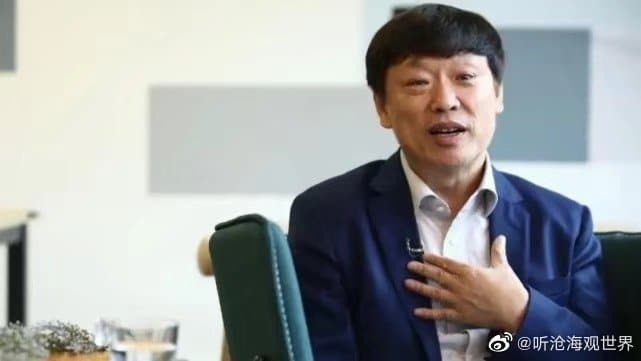
Hu Xijin
In his post, Hu explained the perspectives of people on both sides of the Covid debate, and why many people want China to ‘open up’ while there are also those who are still defending China’s prevention and control measures to contain the virus.
Hu also argued that more experts should come forward with suggestions and views based on science in order for the online discourse to focus more on science and rationality rather than letting the discussions be dominated by loud voices on social media.
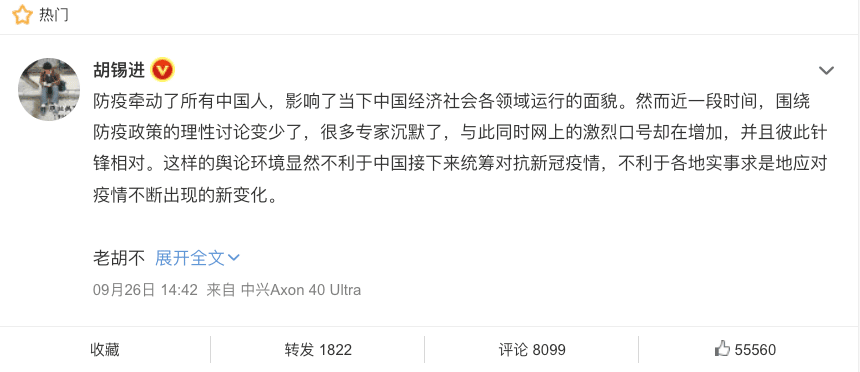
This is a (loose) translation of the full text in Hu Xijin’s post (translation by What’s on Weibo):
“The epidemic has had an influence on all Chinese people, and it has affected the face of China’s current economic and social operations in all areas. Recently, however, there have been fewer reasonable discussions on epidemic prevention policies. Many experts have gone silent while the slogans thrown around on the internet are increasing, and they’re all opposing each other. This public opinion environment is evidently not constructive regarding China’s next steps in the fight against the epidemic, and it certainly doesn’t help to create a realistic response to the continuous changes in the epidemic.”
“I’m not an epidemic expert, but I hope to contribute by promoting rational discussions on epidemic prevention. Let me first go through the two main types of views right now of those calling for “liberalization” and those opposing it.”
“The view of the “liberalization” group: it has been proven that Omikron and its variants simply cannot be contained, and there is overwhelming evidence that these variants already have a lower mortality rate than influenza. Lockdowns in various areas, especially the long ones, severely restrict people’s freedom and are detrimental to physical and mental health. The constant “static management”* (静态管理) everywhere has severely impacted the economy and had led to business closures, unemployment, and depression. Long-term lockdowns and control have also led to China being more shut-off and isolated from the rest of the world. In short, they argue that China holding on to a policy of prevention and control along with the rest of the world is a choice that China should and must make.” [*a type of ‘lockdown’ that still allows some essential businesses and public services to stay open.]
“The view of opponents of “liberalization”: they argue that it is a fact that the epidemic is not over, and that there is no certainty that the virus will continue to weaken – there is still a possibility that the virus will become stronger again. The countries that “let go” [of Covid measures] were forced to do so. But if China opens up, all previous efforts might go to waste and we could face an immense wave of hundreds of thousands of deaths; it would create a serious strain on our healthcare and cause a humanitarian disaster. Although China is currently facing short-term difficulties, the past three years of the epidemic have shown that overall the economic costs of China’s epidemic prevention have been relatively low. We must persevere now, and when the time is ripe we won’t be too late to “liberalize” and, considering everything, another six months or so won’t really matter. It is also not necessarily true that the economy will jump back up once we open up. So many countries across the world have opened up but there are few where the economy is actually doing well. When there are viruses everywhere, there will be a lot of households with elderly people and young children that will stay away from public places. In most areas in China, on the other hand, they are going out without any worries, which supports consumption. They say that China is harming itself by isolating from the world, [but] China’s foreign trade has actually increased since the pandemic and not decreased. A part of foreign trade is experiencing temporary and specific challenges but that does not apply to the overall situation and the reality is that the world’s demand for China is growing.”
“It is worth noting that most of those opposing China ‘opening up’ generally also oppose the arbitrary implementation of “static management” and excessive epidemic prevention, arguing that the ‘one-size-fits-all’ kind of epidemic prevention is a manifestation of local officials in epidemic areas trying to protect official bureaucracy. “
“Overall, there is a political atmosphere surrounding the online discussions on epidemic prevention, and the viewpoints of the people whose voices are the loudest are highlighted. I think this is a bad trend, and we should stop it. I believe that experts should come forward more and publish their suggestions to bring the epidemic discussion back to the realm of science and reason. Even if we can’t completely do it, we should strive to do so.”
“Countries across the world have collectively lost the battle and have accepted the natural consequences of the Covid pandemic, including deaths and Long Covid. Only China is still fighting.”
“In order to advocate [China’s] “liberalization,” we must find reliable answers to some crucial questions. The death rate of Omicron is low, but the infection rate is high, so the overall death total is still not radically reduced – even in America every day a few hundred people are still dying because of it, – how can we solve this problem? When fever and severe cough is all around us, even if it’s not deadly, entire families might fear for the lives of the elderly and their children once they find themselves in such a situation, and everyone will rush to the hospital. How do we prevent our medical systems from becoming overwhelmed? And what’s actually going on regarding Long Covid? The UK has two million cases of Long Covid and the US has around four million cases, it is affecting the quality of life for many people, how do we see this problem? And in case we “open up,” how would it affect the number of people still coming to shopping malls, subway stations, restaurants, and cinemas? China is not like American and European societies, the public’s mental state is relatively fragile. We need experts to come up with credible predictions and measures that can be taken.”
“Those who oppose the easing of preventive and control measures should respond to these kinds of questions: how would we solve the constant ‘static management’ [lockdows] in some regions? How do we address the problems of the travel flow between regions not being smooth and the disruption of supply chains in production areas? Would it be possible for us to achieve, over time, a mature upgrade of the prevention and control system while avoiding widespread lockdowns and obstruction of domestic travel?”
“Omicron is a big problem for humanity, and the reality is that countries across the world have collectively lost the battle and have accepted the natural consequences of the Covid pandemic, including deaths and Long Covid. Only China is still fighting. But this fight is bound to be like navigating a boat against the current. We need to let the whole society grasp the difficulty of this battle, make them understand how hard it is for the country to make “and/and” [both economy and public health-related] strategic decisions to safeguard the interests of 1.4 billion people. There will not be an easy way to solve all the issues and eliminate all systematic problems. China can only constantly weigh in the pros and cons to find the way with the least relative disadvantages. I believe that if we talk things through, although there will always be complaints in the public opinion arena, everyone or at least the majority of people will eventually understand the good intentions and necessity of the country’s strategic decisions, and our society as a collective will continue to keep up with the state policies ahead.”
The post, which received over 55,000 likes, also got many responses.
One popular comment said: “I don’t oppose the epidemic prevention, I oppose how ‘one solution fits all’! As quickly as possible we should push for [local] Health Code apps to recognize each other and stop with making people isolate and stay home in low-risk areas.”
Some people appreciated Hu’s post and were glad that it explicitly stated some issues that are usually not mentioned in official discourse on China’s Covid battle. “Finally someone is admitting that the virus won’t go away,” one commenter said.
But there were also people who thought Hu Xijin was missing some points. One person responded: “The grievances of the people are so deep, yet no official has spoken out, do they think the voices of the people are not important at all?” Another person mentioned: “It’s not that the experts are silent; they are afraid to speak up.” Some asked: “Who has made them go silent?”
“Is our epidemic prevention really still about preventing the epidemic?”
Another Weibo user mentioned that it is not about control versus freedom in China’s Covid fight, but about excessive measures – not too long ago, news that authorities in Xiamen were also doing Covid tests on fish and crabs made its rounds on Weibo: “Isn’t excessive prevention the biggest waste of energy? They’ve opened up in foreign countries for so long, aren’t they the best example? Don’t you want to believe the people? Why are we still worried about Chinese people having a frail mental state? Let’s hurry up and stop this laughable excessive epidemic prevention, we’re all tired.”
“Is our epidemic prevention really still about preventing the epidemic?” others wondered.
There were many people who agreed with this, and one of the top comments said: “I don’t support opening up completely, but I oppose excessive epidemic control, and this is a view that is held by most Chinese.”
Online discussions on the future of China’s Covid policies first started flaring up during the Shanghai lockdown in April of this year, when people started posing questions on why people who barely show any Covid symptoms should still be quarantined at centralized quarantine locations, fearing cross-infection or re-infection due to the crowded and sometimes chaotic living conditions.
At the time, more Chinese officials and experts started emphasizing the importance of sticking to the “dynamic zero-COVID strategy” as the best way forward for China, meaning rapidly responding to new Covid cases, precise prevention measures, and controlling and extinguishing local outbreaks as fast as possible to avoid further spread of the virus and drastically reduce the number of people getting sick.
In order to “amplify authoritative voices” to weigh in on this kind of discussions, Weibo launched its Hongru Open Media Plan (#鸿儒-媒体开放计划#) earlier in 2022, using it as a platform to highlight ‘expert’ opinions.
China’s leading experts on Covid-19, including the renowned scientists Zhong Nanshan (钟南山), Zhang Wenhong (张文宏), and Li Lanjuan (李兰娟), have published and spoken up about the virus and the epidemic situation in China throughout the years.
In a recent interview, Chinese epidemiologist Li Lanjuan said that Covid-19 is a ‘Type B’ infectious disease that is currently managed as a ‘Type A’ infectious disease in China. Type A includes the plague and cholera, while infectious diseases classified as Type B are less severe and include bird flu, malaria, polio, and AIDS.
Li suggested that the management of Covid-19 would, in time, also shift to a ‘Type B’ management system and that Covid-19 will have less of an impact on people’s lives. A Weibo hashtag related to the topic was later taken offline.
Not long after, a hashtag titled ‘How Long Will ‘Dynamic Zero’ Go On?’ (#动态清零政策将持续多久#) was published on Weibo by China Youth Daily, referring to a press conference on September 7 where this question was asked by a foreign reporter. Although Chang Jile (常继乐), deputy director of the National Bureau of Disease Control and Prevention, did not give a concrete answer to the question, he emphasized that scientific research on Covid-19 is still ongoing and that China’s prevention and control measures are still “the most economical and the most effective.”
In the Weibo comment sections, one person wrote: “Still no answers. How long will this go on?”
Read more about Covid in China here.
Read more about Hu Xijin here.
By Manya Koetse
Elements in the featured image by Fusion Medical Animation.
Get the story behind the hashtag. Subscribe to What’s on Weibo here to receive our weekly newsletter and get access to our latest articles:
Spotted a mistake or want to add something? Please let us know in comments below or email us. First-time commenters, please be patient – we will have to manually approve your comment before it appears.
©2022 Whatsonweibo. All rights reserved. Do not reproduce our content without permission – you can contact us at info@whatsonweibo.com.
Manya Koetse is the founder and editor-in-chief of whatsonweibo.com. She is a writer, public speaker, and researcher (Sinologist, MPhil) on social trends, digital developments, and new media in an ever-changing China, with a focus on Chinese society, pop culture, and gender issues. She shares her love for hotpot on hotpotambassador.com. Contact at manya@whatsonweibo.com, or follow on Twitter.

Also Read
China and Covid19
Sick Kids, Worried Parents, Overcrowded Hospitals: China’s Peak Flu Season on the Way
“Besides Mycoplasma infections, cases include influenza, Covid-19, Norovirus, and Adenovirus. Heading straight to the hospital could mean entering a cesspool of viruses.”
Published
8 months agoon
November 22, 2023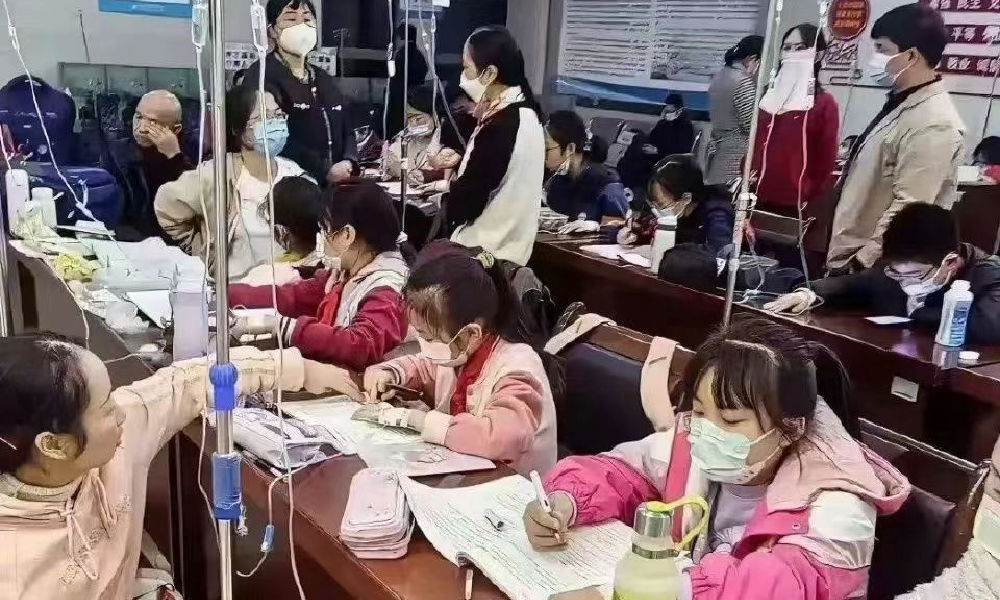
In the early morning of November 21, parents are already queuing up at Xi’an Children’s Hospital with their sons and daughters. It’s not even the line for a doctor’s appointment, but rather for the removal of IV needles.
The scene was captured in a recent video, only one among many videos and images that have been making their rounds on Chinese social media these days (#凌晨的儿童医院拔针也要排队#).
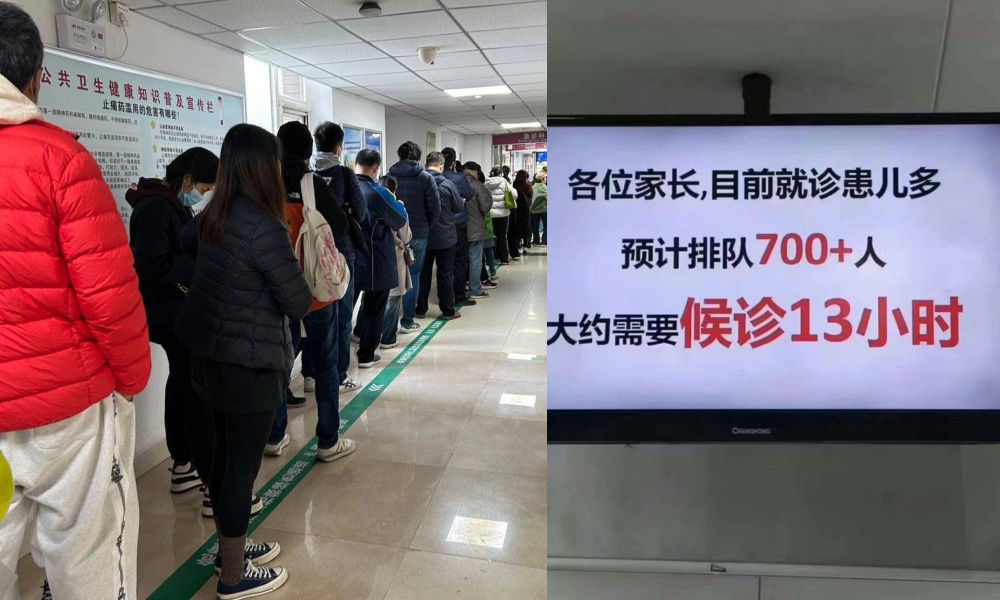
One photo shows a bulletin board at a local hospital warning parents that over 700 patients are waiting in line, estimating a waiting time of more than 13 hours to see a doctor.
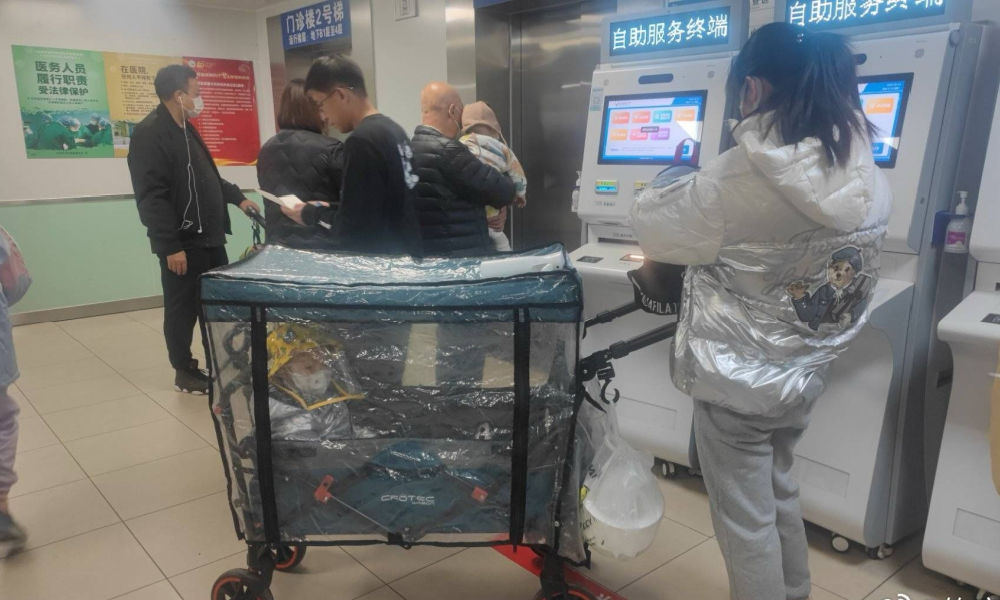
Another image shows children doing their homework while hooked up on an IV.
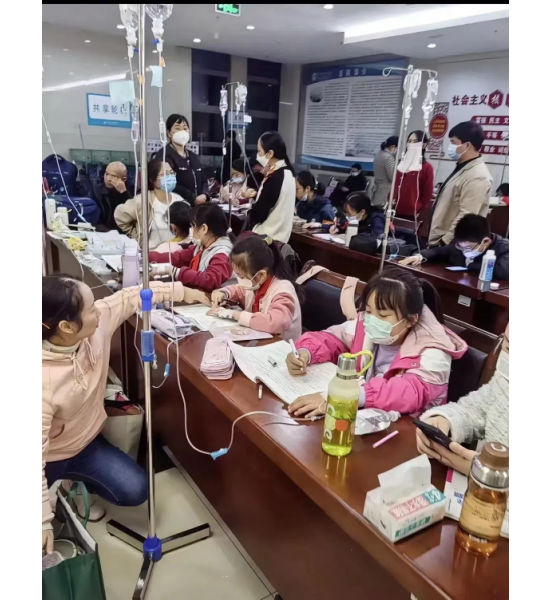
Recent discussions on Chinese social media platforms have highlighted a notable surge in flu cases. The ongoing flu season is particularly impacting children, with multiple viruses concurrently circulating and contributing to a high incidence of respiratory infections.
Among the prevalent respiratory infections affecting children are Mycoplasma pneumoniae infections, influenza, and Adenovirus infection.
The spike in flu cases has resulted in overcrowded children’s hospitals in Beijing and other Chinese cities. Parents sometimes have to wait in line for hours to get an appointment or pick up medication.
According to one reporter at Haibao News (海报新闻), there were so many patients at the Children’s Hospital of Capital Institute of Pediatrics (首都儿科研究所) on November 21st that the outpatient desk stopped accepting new patients by the afternoon. Meanwhile, 628 people were waiting in line to see a doctor at the emergency department.
Reflecting on the past few years, the current flu season marks China’s first ‘normal’ flu peak season since the outbreak of Covid-19 in late 2019 / early 2020 and the end of its stringent zero-Covid policies in December 2022. Compared to many other countries, wearing masks was also commonplace for much longer following the relaxation of Covid policies.
Hu Xijin, the well-known political commentator, noted on Weibo that this year’s flu season seems to be far worse than that of the years before. He also shared that his own granddaughter was suffering from a 40 degrees fever.
“We’re all running a fever in our home. But I didn’t dare to go to the hospital today, although I want my child to go to the hospital tomorrow. I heard waiting times are up to five hours now,” one Weibo user wrote.
“Half of the kids in my child’s class are sick now. The hospital is overflowing with people,” another person commented.
One mother described how her 7-year-old child had been running a fever for eight days already. Seeking medical attention on the first day, the initial diagnosis was a cold. As the fever persisted, daily visits to the hospital ensued, involving multiple hours for IV fluid administration.
While this account stems from a single Weibo post within a fever-advice community, it highlights a broader trend: many parents swiftly resort to hospital visits at the first signs of flu or fever. Several factors contribute to this, including a lack of General Practitioners in China, making hospitals the primary choice for medical consultations also in non-urgent cases.
There is also a strong belief in the efficacy of IV infusion therapy, whether fluid-based or containing medication, as the quickest path to recovery. Multiple factors contribute to the widespread and sometimes irrational use of IV infusions in China. Some clinics are profit-driven and see IV infusions as a way to make more money. Widespread expectations among Chinese patients that IV infusions will make them feel better also play a role, along with some physicians’ lacking knowledge of IV therapy or their uncertainty to distinguish bacterial from viral infections (read more here)
To prevent an overwhelming influx of patients to hospitals, Chinese state media, citing specialists, advise parents to seek medical attention at the hospital only for sick infants under three months old displaying clear signs of fever (with or without cough). For older children, it is recommended to consult a doctor if a high fever persists for 3 to 5 days or if there is a deterioration in respiratory symptoms. Children dealing with fever and (mild) respiratory symptoms can otherwise recover at home.
One Weibo blogger (@奶霸知道) warned parents that taking their child straight to the hospital on the first day of them getting sick could actually be a bad idea. They write:
“(..) pediatric departments are already packed with patients, and it’s not just Mycoplasma infections anymore. Cases include influenza, Covid-19, Norovirus, and Adenovirus. And then, of course, those with bad luck are cross-infected with multiple viruses at the same time, leading to endless cycles. Therefore, if your child experiences mild coughing or a slight fever, consider observing at home first. Heading straight to the hospital could mean entering a cesspool of viruses.”
The hashtag for “fever” saw over 350 million clicks on Weibo within one day on November 22.
Meanwhile, there are also other ongoing discussions on Weibo surrounding the current flu season. One topic revolves around whether children should continue doing their homework while receiving IV fluids in the hospital. Some hospitals have designated special desks and study areas for children.
Although some commenters commend the hospitals for being so considerate, others also remind the parents not to pressure their kids too much and to let them rest when they are not feeling well.
Opinions vary: although some on Chinese social media say it's very thoughtful for hospitals to set up areas where kids can study and read, others blame parents for pressuring their kids to do homework at the hospital instead of resting when not feeling well. pic.twitter.com/gnQD9tFW2c
— Manya Koetse (@manyapan) November 22, 2023
By Manya Koetse, with contributions from Miranda Barnes
Get the story behind the hashtag. Subscribe to What’s on Weibo here to receive our newsletter and get access to our latest articles:
Spotted a mistake or want to add something? Please let us know in comments below or email us. First-time commenters, please be patient – we will have to manually approve your comment before it appears.
©2023 Whatsonweibo. All rights reserved. Do not reproduce our content without permission – you can contact us at info@whatsonweibo.com.
China and Covid19
Repurposing China’s Abandoned Nucleic Acid Booths: 10 Innovative Transformations
Abandoned nucleic acid booths are getting a second life through these new initiatives.
Published
1 year agoon
May 19, 2023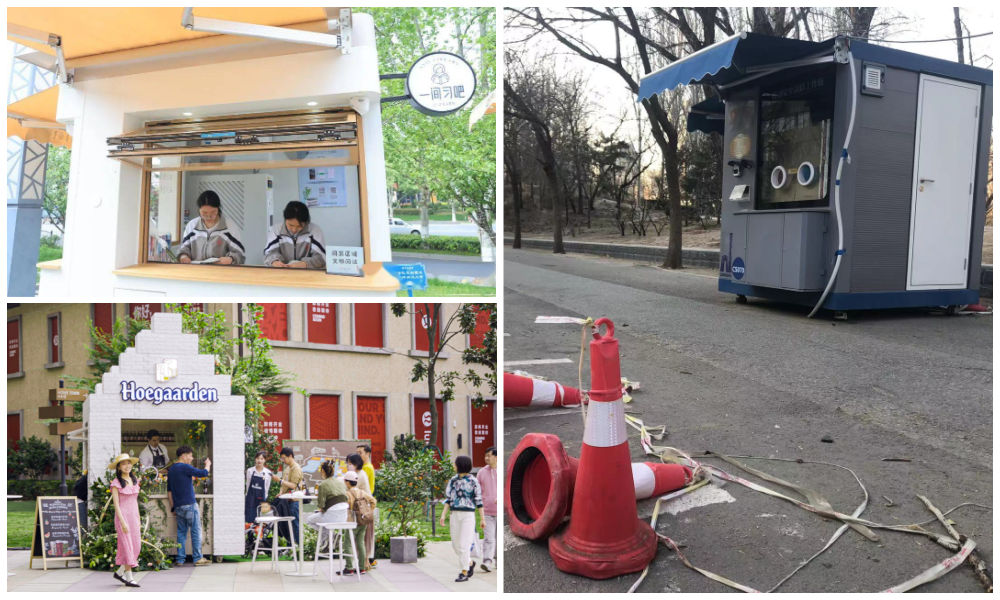
During the pandemic, nucleic acid testing booths in Chinese cities were primarily focused on maintaining physical distance. Now, empty booths are being repurposed to bring people together, serving as new spaces to serve the community and promote social engagement.
Just months ago, nucleic acid testing booths were the most lively spots of some Chinese cities. During the 2022 Shanghai summer, for example, there were massive queues in front of the city’s nucleic acid booths, as people needed a negative PCR test no older than 72 hours for accessing public transport, going to work, or visiting markets and malls.
The word ‘hésuān tíng‘ (核酸亭), nucleic acid booth (also:核酸采样小屋), became a part of China’s pandemic lexicon, just like hésuān dìtú (核酸地图), the nucleic acid test map lauched in May 2022 that would show where you can get a nucleic test.
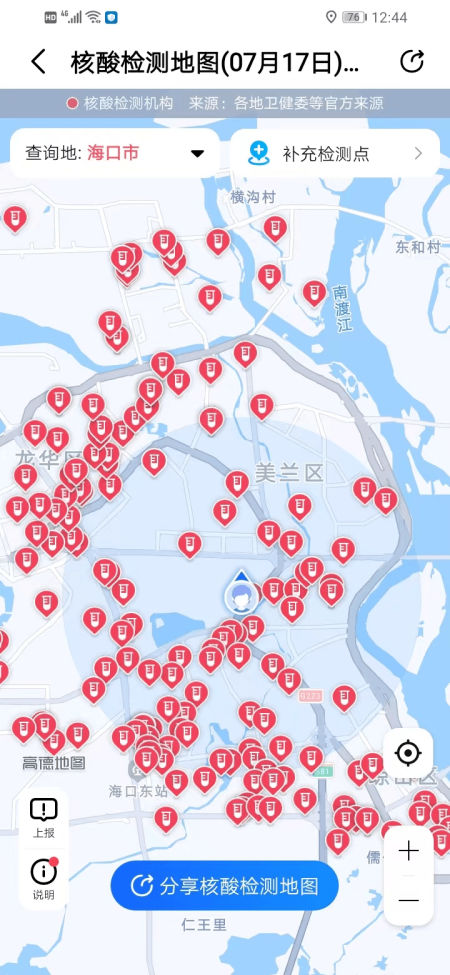
Example of nucleic acid test map.
During Halloween parties in Shanghai in 2022, some people even came dressed up as nucleic test booths – although local authorities could not appreciate the creative costume.
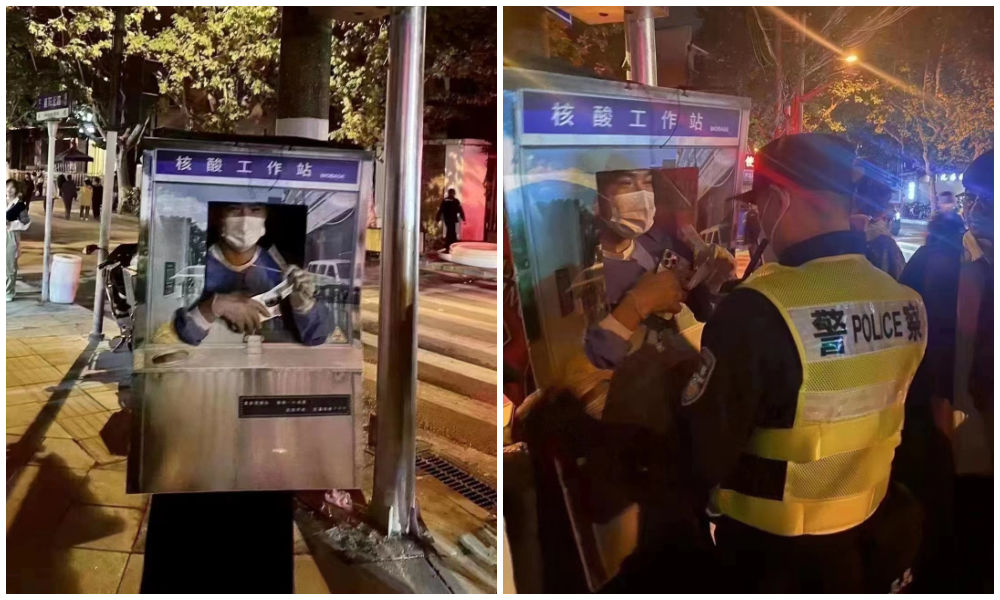
Halloween 2022: dressed up as nucliec acid booths. Via @manyapan twitter.
In December 2022, along with the announced changed rules in China’s ‘zero Covid’ approach, nucleic acid booths were suddenly left dismantled and empty.
With many cities spending millions to set up these booths in central locations, the question soon arose: what should they do with the abandoned booths?
This question also relates to who actually owns them, since the ownership is mixed. Some booths were purchased by authorities, others were bought by companies, and there are also local communities owning their own testing booths. Depending on the contracts and legal implications, not all booths are able to get a new function or be removed yet (Worker’s Daily).
In Tianjin, a total of 266 nucleic acid booths located in Jinghai District were listed for public acquisition earlier this month, and they were acquired for 4.78 million yuan (US$683.300) by a local food and beverage company which will transform the booths into convenience service points, selling snacks or providing other services.
Tianjin is not the only city where old nucleic acid testing booths are being repurposed. While some booths have been discarded, some companies and/or local governments – in cooperation with local communities – have demonstrated creativity by transforming the booths into new landmarks. Since the start of 2023, different cities and districts across China have already begun to repurpose testing booths. Here, we will explore ten different way in which China’s abandoned nucleic test booths get a second chance at a meaningful existence.
1: Pharmacy/Medical Booths
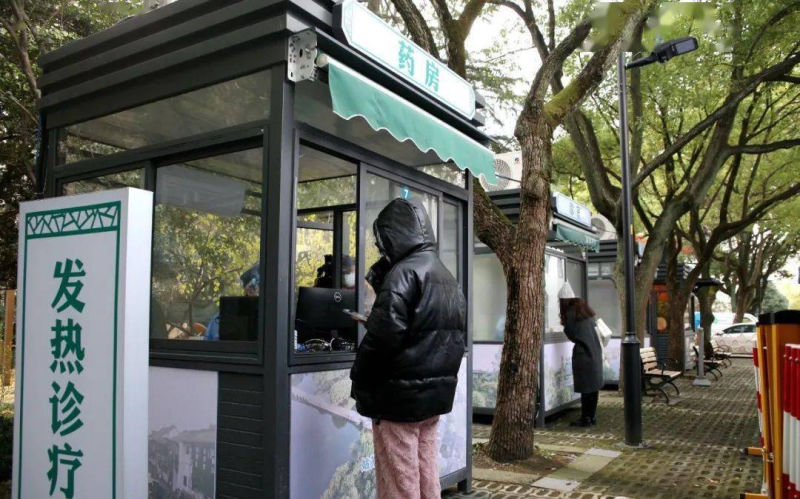
Via ‘copyquan’ republished on Sohu.
Blogger ‘copyquan’ recently explored various ways in which abandoned PCR testing points are being repurposed.
One way in which they are used is as small pharmacies or as medical service points for local residents (居民医疗点). Alleviating the strain on hospitals and pharmacies, this was one of the earliest ways in which the booths were repurposed back in December of 2022 and January of 2023.
Chongqing, Tianjin, and Suzhou were among earlier cities where some testing booths were transformed into convenient medical facilities.
2: Market Stalls
In Suzhou, Jiangsu province, the local government transformed vacant nucleic acid booths into market stalls for the Spring Festival in January 2022, offering them free of charge to businesses to sell local products, snacks, and traditional New Year goods.
The idea was not just meant as a way for small businesses to conveniently sell to local residents, it was also meant as a way to attract more shoppers and promote other businesses in the neighborhood.
3: Community Service Center
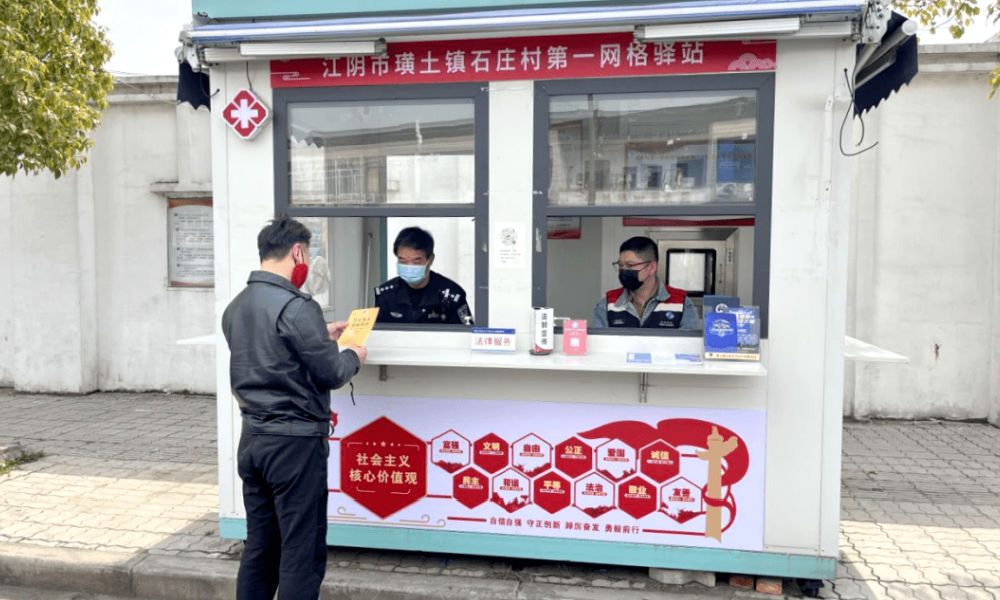
Small grid community center in Shizhuang Village, image via Sohu.
Some residential areas have transformed their local nucleic acid testing booths into community service centers, offering all kinds of convenient services to neighborhood residents.
These little station are called wǎnggé yìzhàn (网格驿站) or “grid service stations,” and they can serve as small community centers where residents can get various kinds of care and support.
4: “Refuel” Stations

In February of this year, 100 idle nucleic acid sampling booths were transformed into so-called “Rider Refuel Stations” (骑士加油站) in Zhejiang’s Pinghu. Although it initially sounds like a place where delivery riders can fill up their fuel tanks, it is actually meant as a place where they themselves can recharge.
Delivery riders and other outdoor workers can come to the ‘refuel’ station to drink some water or tea, warm their hands, warm up some food and take a quick nap.
5: Free Libraries

image via sohu.
In various Chinese cities, abandoned nucleic acid booths have been transformed into little free libraries where people can grab some books to read, donate or return other books, and sit down for some reading.
Changzhou is one of the places where you’ll find such “drifting bookstores” (漂流书屋) (see video), but similar initiatives have also been launched in other places, including Suzhou.
6: Study Space

Photos via Copyquan’s article on Sohu.
Another innovative way in which old testing points are being repurposed is by turning them into places where students can sit together to study. The so-called “Let’s Study Space” (一间习吧), fully airconditioned, are opened from 8 in the morning until 22:00 at night.
Students – or any citizens who would like a nice place to study – can make online reservations with their ID cards and scan a QR code to enter the study rooms.
There are currently ten study booths in Anji, and the popular project is an initiative by the Anji County Library in Zhejiang (see video).
7: Beer Kiosk

Hoegaarden beer shop, image via Creative Adquan.
Changing an old nucleic acid testing booth into a beer bar is a marketing initiative by the Shanghai McCann ad agency for the Belgium beer brand Hoegaarden.
The idea behind the bar is to celebrate a new spring after the pandemic. The ad agency has revamped a total of six formr nucleic acid booths into small Hoegaarden ‘beer gardens.’
8: Police Box

In Taizhou City, Jiangsu Province, authorities have repurposed old testing booths and transformed them into ‘police boxes’ (警务岗亭) to enhance security and improve the visibility of city police among the public.
Currently, a total of eight vacant nucleic acid booths have been renovated into modern police stations, serving as key points for police presence and interaction with the community.
9: Lottery Ticket Booths

Image via The Paper
Some nucleic acid booths have now been turned into small shops selling lottery tickets for the China Welfare Lottery. One such place turning the kiosks into lottery shops is Songjiang in Shanghai.
Using the booths like this is a win-win situation: they are placed in central locations so it is more convenient for locals to get their lottery tickets, and on the other hand, the sales also help the community, as the profits are used for welfare projects, including care for the elderly.
10: Mini Fire Stations

Micro fire stations, images via ZjNews.
Some communities decided that it would be useful to repurpose the testing points and turn them into mini fire kiosks, just allowing enough space for the necessary equipment to quickly respond to fire emergencies.
Want to read more about the end of ‘zero Covid’ in China? Check our other articles here.
By Manya Koetse,
Get the story behind the hashtag. Subscribe to What’s on Weibo here to receive our newsletter and get access to our latest articles:
Spotted a mistake or want to add something? Please let us know in comments below or email us. First-time commenters, please be patient – we will have to manually approve your comment before it appears.
©2023 Whatsonweibo. All rights reserved. Do not reproduce our content without permission – you can contact us at info@whatsonweibo.com.
Subscribe

Weibo Watch: The Future is Here

“Bye Bye Biden”: Biden’s Many Nicknames in Chinese

Enjoying the ‘Sea’ in Beijing’s Ditan Park

A Triumph for “Comrade Trump”: Chinese Social Media Reactions to Trump Rally Shooting

Weibo Watch: Get Up, Stand Up

The Tragic Story of “Fat Cat”: How a Chinese Gamer’s Suicide Went Viral

“Old Bull Eating Young Grass”: 86-Year-Old Chinese Painter Fan Zeng Marries 36-Year-Old Xu Meng

A Brew of Controversy: Lu Xun and LELECHA’s ‘Smoky’ Oolong Tea

Singing Competition or Patriotic Fight? Hunan TV’s ‘Singer 2024’ Stirs Nationalistic Sentiments

Zara Dress Goes Viral in China for Resemblance to Haidilao Apron

Weibo Watch: The Battle for the Bottom Bed

About the “AI Chatbot Based on Xi Jinping” Story

China’s Intensified Social Media Propaganda: “Taiwan Must Return to Motherland”

Weibo Watch: Telling China’s Stories Wrong

Saying Goodbye to “Uncle Wang”: Wang Wenbin Becomes Chinese Ambassador to Cambodia
Get in touch
Would you like to become a contributor, or do you have any tips or suggestions? Get in touch here!
Popular Reads
-

 China Insight3 months ago
China Insight3 months agoThe Tragic Story of “Fat Cat”: How a Chinese Gamer’s Suicide Went Viral
-

 China Music4 months ago
China Music4 months agoThe Chinese Viral TikTok Song Explained (No, It’s Not About Samsung)
-

 China Digital10 months ago
China Digital10 months agoToo Sexy for Weibo? Online Discussions on the Concept of ‘Cābiān’
-

 China Arts & Entertainment12 months ago
China Arts & Entertainment12 months agoBehind 8 Billion Streams: Who is Dao Lang Cursing in the Chinese Hit Song ‘Luocha Kingdom’?





